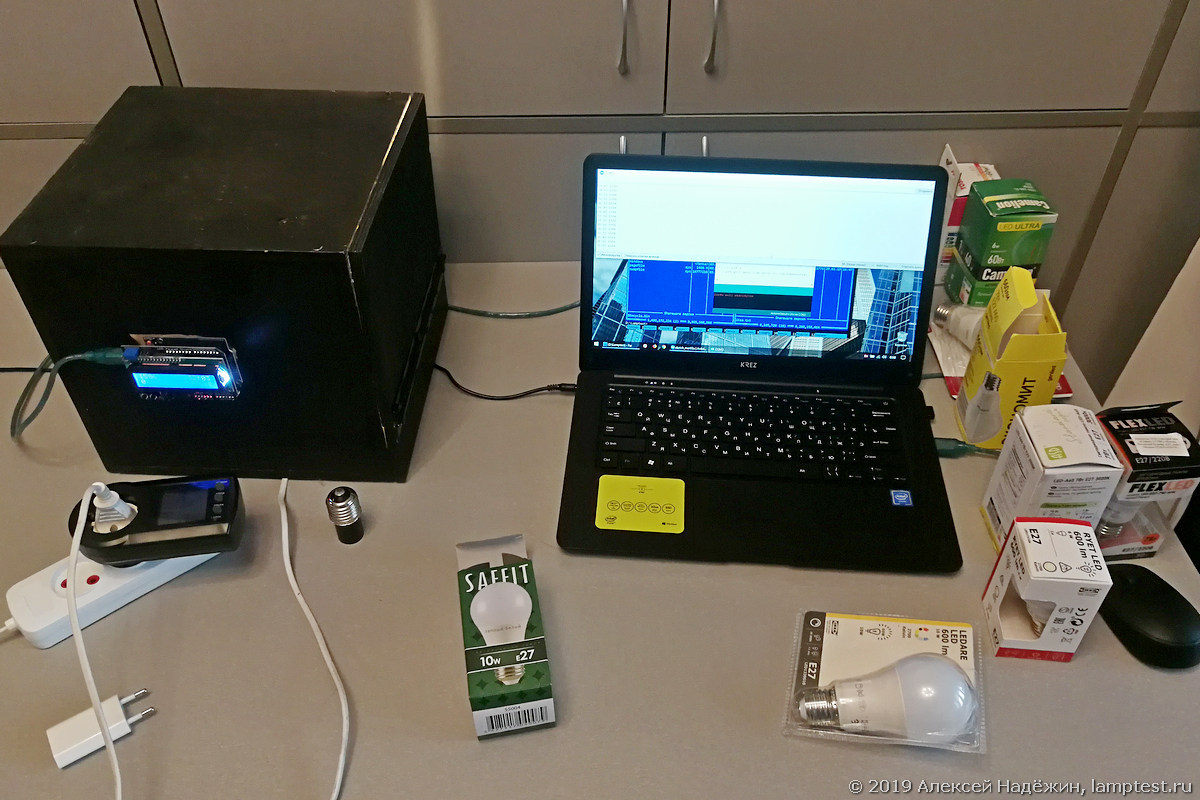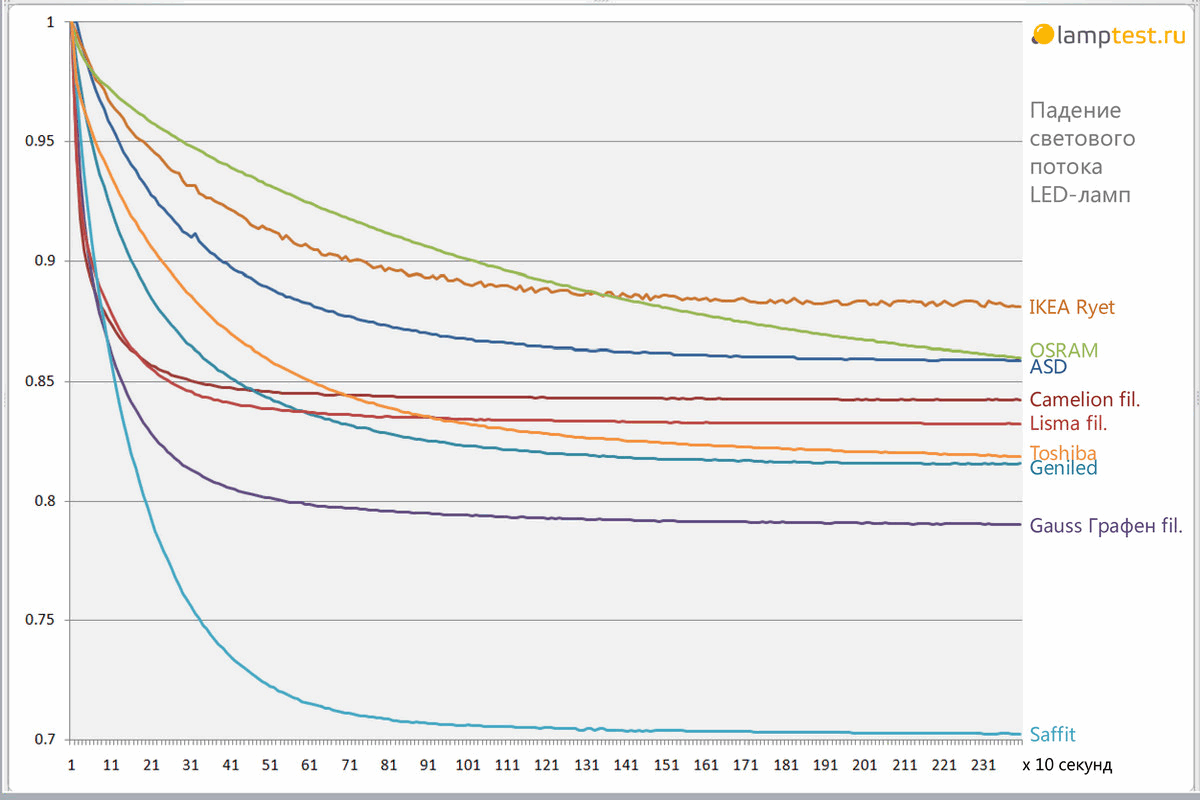The durability of LED lamps and reduced luminous flux
I conducted an experiment and compared how the luminous flux of various LED lamps decreases within forty minutes after switching on.

Before any testing, I definitely warm up the LED lamps for at least 30 minutes. The fact is that any LED lamp during this time reduces its luminous flux as the LEDs and electronics warm up.
Using the self-made “black box” Lamptest-1, I measured how the luminous flux of twelve different LED lamps changes in the first forty minutes after switching on. For clarity, selected nine of them:
')
IKEA Ryet 603.979.60 LED1741G6 ;
OSRAM LEDSCLA60 10W / 827 230VFR E27 ;
ASD LED-A60-std 7W E27 3000K 630Lm ASD ;
Camelion LED ULTRA LED6-A60-FL / 830 / E27 filament;
Lisma SDF-6 A50 filament;
Toshiba 00101315012B ;
Geniled 01327 ;
Gauss 102802115 Graphene filament;
Saffit SBA6010 55004 .
That's what happened.

The first thing that catches your eye is a significantly greater decrease in brightness (hereinafter, I will use this word, not as a technical term, but as an everyday concept) in a Saffit lamp. After 25 minutes, the luminous flux of this lamp fell to almost 70% of the initial. I note that this is a very, very bad light (10 W is declared, 5 W is in fact, CRI 80 is declared, 72 is in fact, the luminous flux has not yet been measured, but I think it is also in the region of half of the declared). Such a drop indicates that the LEDs are likely to operate in overload mode. For a long time such a light bulb will not work.
The second interesting point is the difference in the graphs of the three filament lamps. They heat up faster and stabilize faster. In the Camelion lamp, the luminous flux stabilized within five minutes after switching on and after that within 35 minutes it dropped by only 1%.
An interesting chart for an old OSRAM lamp with a heavy radiator (the lamp weighs as much as 117 grams). It warms up so slowly that even 40 minutes was not enough to fully stabilize the luminous flux.
The wavy graph of IKEA Ryet is caused by the pulsation of light (its pulsation coefficient is about 13%).
Perhaps according to the degree of luminous flux, you can make a prediction of the durability of the lamps and if the brightness has fallen by more than 20% in 15 minutes, the probability of a premature lamp failure is quite high.
So far I have no way to test each lamp in this way, but if you make a special firmware for Lamptest-1 and make several pieces of the devices themselves, the process can be fully automated and put on stream.
© 2019, Alexey Nadyozhin

Before any testing, I definitely warm up the LED lamps for at least 30 minutes. The fact is that any LED lamp during this time reduces its luminous flux as the LEDs and electronics warm up.
Using the self-made “black box” Lamptest-1, I measured how the luminous flux of twelve different LED lamps changes in the first forty minutes after switching on. For clarity, selected nine of them:
')
IKEA Ryet 603.979.60 LED1741G6 ;
OSRAM LEDSCLA60 10W / 827 230VFR E27 ;
ASD LED-A60-std 7W E27 3000K 630Lm ASD ;
Camelion LED ULTRA LED6-A60-FL / 830 / E27 filament;
Lisma SDF-6 A50 filament;
Toshiba 00101315012B ;
Geniled 01327 ;
Gauss 102802115 Graphene filament;
Saffit SBA6010 55004 .
That's what happened.

The first thing that catches your eye is a significantly greater decrease in brightness (hereinafter, I will use this word, not as a technical term, but as an everyday concept) in a Saffit lamp. After 25 minutes, the luminous flux of this lamp fell to almost 70% of the initial. I note that this is a very, very bad light (10 W is declared, 5 W is in fact, CRI 80 is declared, 72 is in fact, the luminous flux has not yet been measured, but I think it is also in the region of half of the declared). Such a drop indicates that the LEDs are likely to operate in overload mode. For a long time such a light bulb will not work.
The second interesting point is the difference in the graphs of the three filament lamps. They heat up faster and stabilize faster. In the Camelion lamp, the luminous flux stabilized within five minutes after switching on and after that within 35 minutes it dropped by only 1%.
An interesting chart for an old OSRAM lamp with a heavy radiator (the lamp weighs as much as 117 grams). It warms up so slowly that even 40 minutes was not enough to fully stabilize the luminous flux.
The wavy graph of IKEA Ryet is caused by the pulsation of light (its pulsation coefficient is about 13%).
Perhaps according to the degree of luminous flux, you can make a prediction of the durability of the lamps and if the brightness has fallen by more than 20% in 15 minutes, the probability of a premature lamp failure is quite high.
So far I have no way to test each lamp in this way, but if you make a special firmware for Lamptest-1 and make several pieces of the devices themselves, the process can be fully automated and put on stream.
© 2019, Alexey Nadyozhin
Source: https://habr.com/ru/post/442630/
All Articles